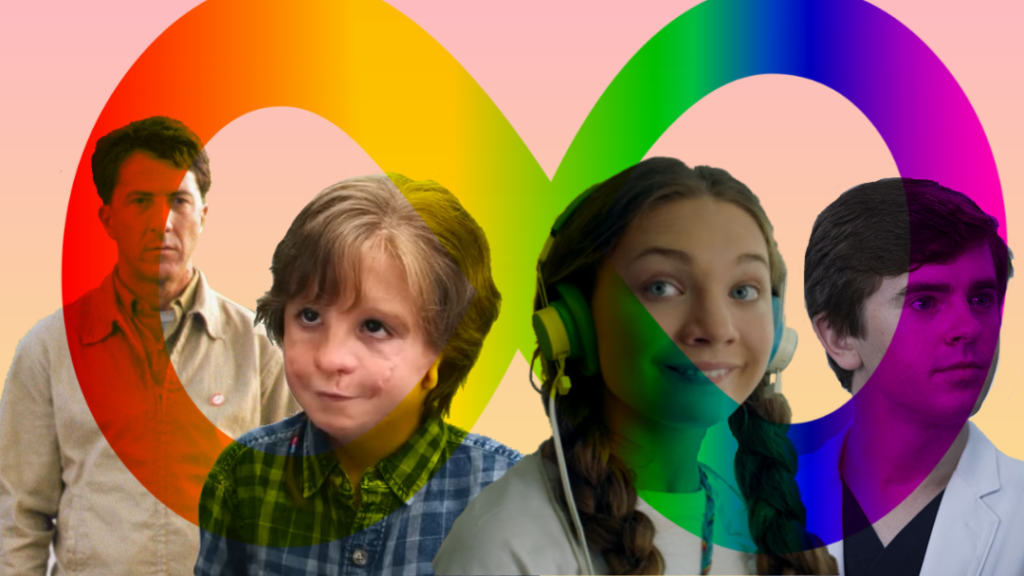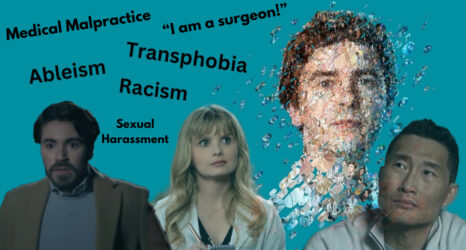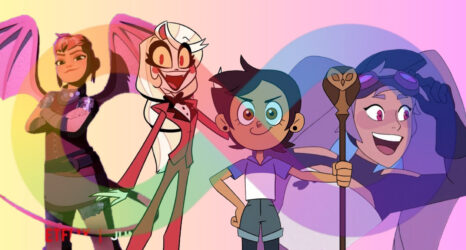The autism and disability community has endured a long history of being excluded and ignored by Hollywood—even in the telling and making of their own stories.

While many praise Hollywood for its “progressive” depictions of Black and LGBTQ characters, one group still continues to face a lack of true and respectful representation from the mainstream media: disabled people, especially autistic people.
“It’s sad how [Hollywood is] so progressive, they’ve really moved forward when it comes to representation,” Catherine Burford, an autistic writer, told Ms. “But not with the disabled community. They’re still like in the past with how they portray it. They still like to rely on those who are not disabled [to portray disabled characters].”
This sentiment has been shared by many in the disabled community. In a 2016 interview with The Washington Post, Jay Ruderman, president of the Ruderman Family Foundation, called the lack of true disability representation “a civil rights issue that Hollywood is ignoring.”
“We’ve progressed with other minority groups,” Ruderman said. “With disability, the representation is still woefully inadequate, and we think that’s based on a stigma that’s prevalent in society and also in Hollywood.”
For many in the autism community, the way Hollywood chooses to present them is counterproductive and often defines them by their disability. “You don’t see them as a person; you see them as their disability,” said Tim Boykin, an autistic singer, actor and writer.
Similarly, Robin Roscigno, an autistic educator, educational researcher and founder of AuTeach, lamented how many disabled characters are in some way defined by their disability, without any autonomy.
“Disabled people are not given space to be full characters in of themselves. … We don’t really get a lot of like love stories of disabled people. Disabled people … having any kind of romance or any, like, action or anything that [where] the storyline is not just about the disability, [but] where it’s about disabled people being like, whole real people where disability is a part of our lives, but it’s not the only part of our lives.”
The Art of ‘Cripping Up’
When making films and TV shows about disability, Hollywood often excludes disabled people from the production. Many times disabled characters—such as Dr. Sean Murphy in The Good Doctor and Augie in Wonder —are played by able-bodied, neurotypical actors. Many disabled people call this tactic “cripping up.”
“The art of ‘cripping up’—where non-disabled actors play disabled roles—is still prevalent, taking work and opportunities from an already grossly marginalized and underrepresented group,” said disability rights activist Samantha Renke.
Rebecca Faith Quinn, an autistic actor, writer, producer and TikTok autism acceptance activist, called out the double standard of neurotypical people pretending to be disabled on camera:
“It just irritates me because it’s just like, if you watch [a] movie, knowing that this is a neurotypical person who is not disabled playing a disabled person, I don’t understand why it doesn’t make you, make a person uncomfortable. Because in any other stance, if you pretend to be a disabled person, for money, people will just like they’ll rip you apart. They’ll be like, ‘that’s so offensive’, ‘that’s so horrendous.’ But the second you put a camera in front of them, it’s okay.”
Though many in the disabled community are tired of able-bodied neurotypical actors playing disabled characters, some—like Will Lasley, an autistic stand-up comedian, actor, writer and film critic—admit “it’s not impossible to get a good performance from a neurotypical actor.” Lasley provides the 2020 horror film Come Play as an example. In it, actor Jacob Chase depicts a non-speaking autistic boy, played by neurotypical 11-year-old actor Azhy Robertson, in what Lasley stated was “one of the best performances of an autistic character I’ve ever seen a neurotypical actor give.”
Disability as ‘Inspiration Porn’
Coined by Australian disability rights activist Stella Young in 2012, inspiration porn is defined as the representation of disabled people as inspirational, in whole or in part due to their disability. According to Young, the use of the word ‘porn’ in this particular term was “deliberate, because they objectify one group of people for the benefit of another group of people. So, in this case, we’re objectifying disabled people for the benefit of nondisabled people.”
Just as porn has historically objectified women for the pleasure of men, inspiration porn, as Burford puts it, “is pretty much a way for non-disabled people to portray disabled people in order to make them feel better about themselves.”
According to Young in a 2014 TedTalk, many people have only “experienced disabled people as objects of inspiration. … For lots of us, disabled people are not our teachers or our doctors or our manicurists. We’re not real people. We are there to inspire.”
“We’ve been sold the lie that disability is a bad thing… and to live with a disability makes you exceptional. It’s not a bad thing and it doesn’t make you exceptional.”
—Stella Young
Renke voiced similar disdain for this common narrative, and says it’s “often fueled by the media when describing disabled people in order to make the non-disabled feel good about themselves. … The narrative being that ‘they overcame’ their disability while non-disabled people are praised for helping disabled people achieve these supposed triumphs.”
According to Kristen Ginger, director of the National Center on Disability and Journalism (NCDJ), “It’s well-intentioned, but those stories also can be very exploitative and they are very limited in really getting to the heart of how people live and what they think and how they’re affected by what’s going on in our civic life.”
“When it comes to autism, they’re always going down with the Rain Man storylines, the inspirational porn and whatnot, treating them as props rather than actually the actual main characters,” said Burford. “They’re literally unimaginative; there’s literally just recycling Rain Man over and over again. They’re not taking risks.”
According to Magda Romanska, an associate professor of theatre and dramaturgy at Emerson College, “The issue of representation—what kind of characters these actors play—remains mostly unaddressed. The vast majority of characters with disabilities, whether they’re played by actors with disabilities or not, continue to represent the same outdated tropes.”
The Four Types of “Cripples”
While inspiration porn is definitely the most common archetype for disabled characters, it is not the only one. Romanska detailed the four typical tropes disabled characters are often limited to:
1. Inspirational Cripple
Most “inspirational cripple” roles equate to inspiration porn.
“These stories center on disabled people accomplishing basic tasks or ‘overcoming’ their disability,” said Romanska. “In the inspirational narratives, disability is not a fact of life—a difference—but something one has to overcome to gain rightful sense of belonging in society.”
According to Renke:
“We are just human beings, not examples to be dragged out whenever non-disabled people want someone to label as a drain on society and blame for an economic downturn, or when they need a morale boost and reality check. Those who spread inspiration porn do so because, on a conscious or unconscious level, they identify the barriers disabled people face, brought about mostly by systemic ableism. But instead of becoming a disability advocate, they leave us with a hollow word and use our persecution for their own sense of feeling good about themselves.
Many disabled people have described inspiration porn as portraying the act of a disabled person living their lives as something for non-disabled people to be “inspired by.”
“The existence of someone should not be considered ‘inspirational,’ just because they’re different.” said Ariel Henley, a writer born with Crouzon syndrome. In an op-ed published by Teen Vogue, Henley expressed distain over the depiction of a character with facial deformities in the film Wonder:
“In Wonder, Auggie is used as a prop to teach those around him about acceptance and compassion. The official movie description deems him ‘the most unlikely of heroes.’ But what is he a hero for, exactly? For living with a disfigured face? For not getting angry when he’s subjected to cruel and intense bullying on a daily basis? For going through traumatic medical procedures? You may find someone inspiring for how they handle a certain situation, or the humor they use to cope with adversity, for example.
“The mere existence of individuals with facial disfigurements or differences is not inspirational. We are so much more than the props we’ve been turned into, designed to make non-disfigured individuals feel better about their lives. Our stories matter and our experiences matter, and to portray our lives and struggles as nothing more than a source of inspiration encouraging those without craniofacial disorders to feel better about themselves, is a great disservice to everyone in the cranio community.”
2. Redemptive Cripple
Romanska describes the “redemptive cripple” as an offshoot of the “inspirational cripple”—in which the disabled character dies, sometimes by suicide or murder. “Disabled characters are sacrificed to prove their worth or to help the protagonist reach his goal,” said Romanska.

Roscigno calls this trope “kind of a hybrid of a couple of different models: one where the person themselves are redeemed, or [the other] where they redeem others”:
“There’s two versions of [the redemptive cripple]. There’s one where people view disability as some sort of moral failing. Like, ‘you are disabled, you didn’t try enough.’ And so you know, people will ‘overcome their disability.’ And then there’s another version where the child or you know, person’s disability becomes a redemptive arc for their caretaker.”
3. Magical Cripple
The “magical cripple” trope is essentially the disability version of the popular (and racist) “magical Negro” cliche. Just as a “magical Negro” character exists only to serve the white protagonist—think Uncle Remus in Song of the South—with wisdom and lessons that help them develop and grow, a “magical cripple” character is used as “a plot device … to guide the lead character toward moral, intellectual or emotional enlightenment,” said Romanska.
“Magical cripples transcend the limitations of the human body and are almost divinelike,” she continued. “They make magical things happen for able-bodied characters. … The magical cripple doesn’t learn anything and doesn’t grow because he already is enlightened.”
According to Roscigno, the “magical cripple” character doesn’t have any agency and does not receive a full narrative portrayal from the screenwriters or even anyone watching it: “It becomes more about disabled stories existing only to serve non-disabled audiences.”
4. Evil Cripple
Lastly, the “evil cripple” archetype is one of the less-talked about disability archetypes. Rooted in Greek mythology “populated by half-man half-beasts who possess pathological and sadistic cravings,” the “evil cripple” according to Romanska, “represents a form of karmic punishment for the character’s wickedness.”
A modern example of this trope is presented in the horror film Us, in which Academy Award winning actress Lupita Nyong’o uses what she said was “inspired by” spasmodic dysphonia, a voice disorder that causes involuntary spasms to the vocal chords, to create a “creepy voice” for her character Adelaide’s evil double Red (also played by Nyong’o).
Many autistic people say this archetype is less seen in depictions of autistic characters. Others, like Roscigno, have a different interpretation of the trope.
“It’s like the whole, like, ‘trapped inside my mind’ narrative with autism. People kind of tend to perpetuate that autism is somehow like in closing or, you know, shielding like your real child that is somehow underneath all of that,” said Roscigno.
Impact on Disabled People
Because of the constant inaccuracy in these portrayals of disability, as well as a lack of media that includes accurate representation, the general public’s image of disability becomes distorted to the reality and nuances of what disability looks like.
“To other autistic people, I certainly look and act autistic,” autistic artist and audio describer Meg told Junkee.”To anyone without knowledge in the area, I may appear ‘just a little weird’. Their image of autism was informed by inaccurate media.”
“This may seem harsh, but as a disabled woman that’s what I see: disabled people used as puppets for onlookers to ogle. Of course, disabled people can inspire and are badass human beings, that’s not up for discussion. Nevertheless, I’ll always challenge the sentiment behind the word ‘inspirational’.”
—Samantha Renke
While many filmmakers and actors can have, or at least claim, good intentions in the way they depict disability, many disabled people face the societal repercussions of such on-screen portrayals of who they are.
“Basically, we are just there for like, inspiration,” Boykin said. “Neurotypicals like to speak over us. They do it out of good faith when in fact they are overshadowing us. They believe it’s their ‘woke points’ that make it all better.”
The effects of how the misrepresentation of disabilities, particularly autism, go far beyond those who consume it. According to one study, “media representations of talent and special abilities can be said to have contributed to a harmful divergence between the general image of autism and the clinical reality of the autistic condition.”
While inaccurate, negative depictions of disabilities do affect how other neurotypical people view disability. They also impact how disabled people may view themselves. As Henley states, “I’ve gone my entire life without ever seeing someone with life experiences similar to my own represented on the big screen. On the rare occasion that people with facial disfigurements have been portrayed in the media, we’re too often reduced to tired villain tropes or overly-sentimental tales that scream inspiration porn.”
Even films like Wonder, which many disabled people have referred to as inspiration porn, admittedly have “an element of them that are enjoyable if you can, like suspend your criticality,” said Roscigno. “In some ways, like, we’re so thirsty for like, any representation that even bad representations seems okay, sometimes because there is none. So when we get something that’s not like, overtly terrible, it sometimes feels okay in the moment, because you’re like, well, there’s not anything else.”
Some may argue against any real-life consequences many depictions of disability can have, but many actual disabled people say those consequences are real and affect everyone. “It narrows people’s perceptions of what autism can look like,” says Lasley.
He references a joke he made in one of his stand-up acts:
“The joke is basically saying, you know, it’s called a spectrum for a reason. We don’t all act one way. You know, just because you saw one movie about someone with autism doesn’t mean everyone who’s autistic acts like that. We’re not all Rain Man. Just like everyone who’s a mall security guard isn’t a fat doofus who’s funny in small doses, but not really enough to carry a whole movie.”
Moving Beyond Disability Stereotypes to True Representation
Luckily, there are ways that Hollywood and society can improve, as many in the disability community have stated.
With 95 percent of disabled characters being portrayed by non-disabled actors, one of the biggest requests the disabled community has for Hollywood is to start casting more disabled actors in the roles of disabled characters.
“With only two Oscar winners openly having a disability in the entire 93 years of the awards, it is even more important to give disabled artists the platform they deserve,” said Renke. “Not only is seeing authentic representation empowering and makes me feel like I belong, it also … ‘normalizes’ disability. It shares our world with others. We live in a different time and we live in a time where autistic actors are on the come-up.”
“To me, my big request and sort of note for, you know, people wanting to make movies about disabled people … give them more traits than just disabled. Make them, you know, three-dimensional people, as well as being disabled,” said Lasley.
Boykin also suggests filmmakers “talk to autistic people. Learn about autism. Hire autistic actors or writers. It also creates a good story. … Show stimming”—self-sensory regulating behaviors and mechanisms—”as not the end of the world. And actually, like show an autistic person as a person. Not just a plot device. We have a lot of talent, so please give us a chance.”
Up next:





